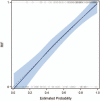Coagulation parameters predictive of repeated implantation failure in Chinese women: A retrospective study
- PMID: 33235093
- PMCID: PMC7710181
- DOI: 10.1097/MD.0000000000023320
Coagulation parameters predictive of repeated implantation failure in Chinese women: A retrospective study
Abstract
Repeated implantation failure (RIF) greatly influences pregnancy rate after assisted reproductive technologies (ART) with elusive causes. Our study aimed to explore coagulation parameters in association with RIF and establish a model to predict the risk of RIF in Chinese women.Coagulation parameters, including prothrombin time (PT), thrombin time (TT), activated partial prothrombin time (APTT), D-dimer (DD), fibrin degradation products (FDP), fibrinogen (FG), and platelet aggregation induced by arachidonic acid (AA) and adenosine diphosphate (ADP) were measured in RIF patients and controls. A logistic regression model was built by using the purposeful selection to select important factors for the prediction of RIF.Between 92 RIF patients and 47 controls, we found a statistically significant difference in all of the coagulation parameters except APTT, FDP and platelet aggregation induced by ADP. The purposeful selection method selected PT (odds ratio [OR] = 0.28, 95% CI: 0.12-0.66, P = .003), APPT (odds ratio [OR] = 0.76, 95% CI: 0.63-0.91, P = .004), TT (odds ratio [OR] = 0.75, 95% CI: 0.53-1.08, P = .124), and platelet aggregation induced by AA (odds ratio [OR] = 1.27, 95% CI: 1.11-1.44, P = .0003) as important predictors of RIF risk. ROC curve analysis indicated that the area under ROC curve (AUC) of the model was 0.85 with an optimal cut-off point of the predicted probability being P = .65, leading to a sensitivity of 0.83 and a specificity 0.75.We found that coagulation parameters including PT, APTT, TT and platelet aggregation induced by AA are predictive of RIF in Chinese women. Our results highlight the potential of anti-coagulation therapies to lower the risk of RIF.
Conflict of interest statement
The authors have no conflicts of interest to disclose.
Figures


References
-
- Coughlan C, Ledger W, Wang Q, et al. Recurrent implantation failure: definition and management. Reprod Biomed Online 2014;28:14–38. - PubMed
-
- Centers for Disease Control and Prevention (CDC) Assisted reproductive technology and trends in low birthweight--Massachusetts, 1997-2004. MMWR Morb Mortal Wkly Rep 2009;58:49–52. - PubMed
-
- Nyboe Andersen A, Goossens V, Bhattacharya S, et al. Assisted reproductive technology and intrauterine inseminations in Europe, 2005: results generated from European registers by ESHRE: ESHRE. The European IVF Monitoring Programme (EIM), for the European Society of Human Reproduction and Embryology (ESHRE). Hum Reprod 2009;24:1267–87. - PubMed
-
- European IVFMCftESoHR, Embryology, Calhaz-Jorge C, et al. Assisted reproductive technology in Europe 2012: results generated from European registers by ESHRE. Hum Reprod 2016;31:1638–52. - PubMed
-
- Quan S, Liu J. Definition of recurrent implantation failure and associated factors. J Pract Obstetr Gynecol 2018;34:321–4.
Publication types
MeSH terms
LinkOut - more resources
Full Text Sources
Medical

